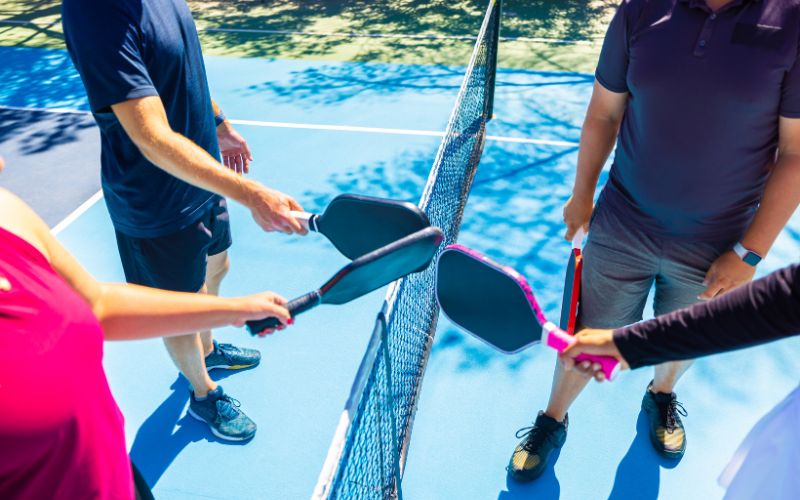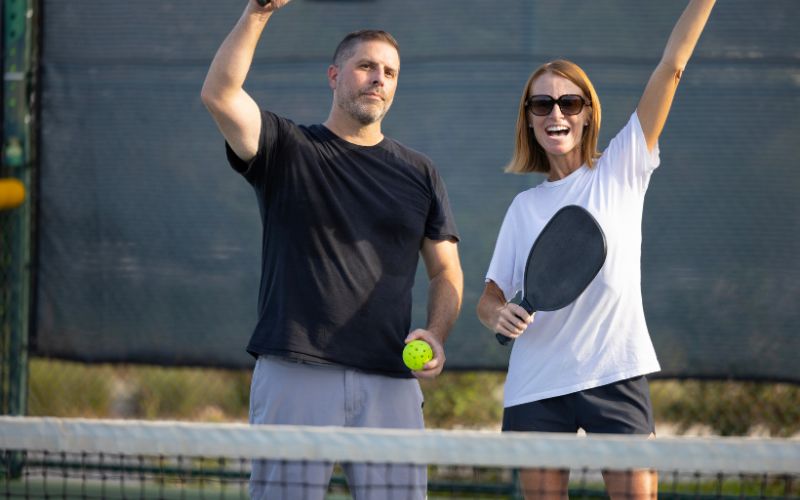Pickleball, a sport that marries elements of tennis, badminton, and table tennis, has gained immense popularity in recent years. As players immerse themselves in this fast-paced, strategic game, they often encounter advanced techniques like the BERT show that elevate their gameplay. In this comprehensive guide, we will delve into What is a BERT in Pickleball?, its depths, context, and explore its nuances, advanced technique, and strategic applications.
Understanding How to Play Pickleball
Before diving into the intricacies of the BERT shot, let’s briefly outline the fundamental aspects of pickleball. Played on a pickleball court resembling a smaller tennis court, pickleball involves hitting a perforated plastic ball over a net. Players use solid paddles to volley the ball back and forth, aiming to score points. The court is divided into specific areas, including the non-volley zone (NVZ), kitchen line, and boundaries that form the rules and dynamics of the game.
The Significance of the Non-Volley Zone (NVZ) Line
One of the essential elements in pickleball is the non-volley zone or NVZ, a seven-foot area adjacent to the net on both sides of the court. Players cannot hit the ball in the air while standing within this zone unless the ball bounces first. Mastering shots within this limited space often distinguishes experienced players from beginners.
Introduction to the BERT Shot
The BERT shot, also known as the “Erne shot” or “Ernie,” is an advanced technique in pickleball that involves hitting the ball on the opposite side of the court while jumping or stepping outside the NVZ to make contact with the ball before it bounces. This shot requires precise timing, agility, and strategy. Players execute the BERT shot by positioning themselves close to the NVZ line on one side of the court and hitting the ball on the opposite side, usually aiming for a surprise attack.
Executing the BERT Shot: Technique and Strategy
To perform a BERT shot, players need to anticipate the opponent’s shot and position themselves accordingly. As the opponent hits the ball towards your side, move quickly towards the non-volley zone line, timing your jump or step so that you can make contact with the ball before it bounces. The objective is to hit the ball diagonally across the court to catch your opponents off-guard.
The BERT shot demands a high level of skill, control, and awareness of your position on the court. Additionally, it’s crucial to keep in mind the rules regarding the NVZ, ensuring that your feet don’t touch the NVZ while executing the shot.
Technique of the BERT Shot:
- Positioning: To initiate the BERT shot, stand close to the non-volley zone (NVZ) line on one side of the court. Anticipate the opponent’s shot and be prepared to move swiftly towards the opposite side of the court where the ball is directed.
- Footwork: Quick and precise footwork is key. As the opponent hits the ball towards your side, move swiftly towards the NVZ line and time your movement so that you can make contact with the ball before it bounces.
- Timing: The timing of your jump or step is crucial. You aim to contact the ball while it’s still mid-air or just before it bounces. This timing is critical to execute the shot effectively and catch your opponents off-guard.
- Paddle Control: Maintain control over your paddle. The angle and direction of your paddle swing will determine where the ball lands on the opposite side of the court. Practice controlling your paddle to precisely direct the ball across the net.
Strategy of the BERT Shot:
Integrating the BERT shot into your gameplay can be a game-changer. It adds an element of surprise, catching opponents off guard and putting them on the defensive. This advanced technique can be particularly effective when opponents are positioned closer to the net or are not expecting a shot from an unconventional angle.
- Surprise Element: The BERT shot is all about surprise and forcing your opponents out of their comfort zone. Use it strategically when opponents are positioned closer to the net or are not expecting a shot from your side of the court.
- Creating Openings: This shot can create openings in your opponent’s defense. By hitting the ball diagonally across the court, you might force them to move quickly or take an awkward shot, giving you an advantage.
- Variation: Mix up your shots during a game. Incorporating the BERT shot sporadically keeps opponents guessing and prevents them from predicting your next shot. This unpredictability can be a powerful asset.
- Observation and Adaptation: Pay attention to your opponent’s position and movements. If you notice they are slow to react to shots on the opposite side or tend to cover one area more than another, use this information to your advantage when attempting the BERT shot.
- Risk vs. Reward: Understand the risk involved in attempting a BERT shot. If executed well, it can earn you a point or put you in a favorable position. However, if mistimed or misdirected, it can result in losing the point.
Differentiating the BERT Shot from Regular Plays
The key difference between a BERT shot and regular plays lies in the execution and positioning. While conventional shots involve hitting the ball after it bounces, the BERT shot requires players to strike the ball mid-air or before it bounces, adding an element of surprise and forcing opponents to adjust quickly.
Mastering the BERT Shot: Practice and Persistence
Like any advanced technique in pickleball, mastering the BERT shot requires practice, patience, and a deep understanding of the game’s dynamics. Players should focus on timing, footwork, and precise paddle control to consistently deliver this shot effectively during gameplay.
Common Mistakes and How to Avoid Them
Executing the BERT shot correctly can be challenging, and beginners may make mistakes, such as:
- mistiming the jump,
- hitting the ball out of bounds, or
- failing to surprise the opponent.
To avoid these errors, players should practice the shot extensively, honing their skills and gradually integrating it into their gameplay.
Watching, Learning, and Integrating Strategies
Watching videos of experienced players executing the BERT shot can offer valuable insights into its execution and strategic applications. Observing their techniques, footwork, and positioning can help aspiring players understand the nuances and improve their own gameplay.
Elevating Your Pickleball Game with the BERT Shot
In conclusion, the BERT shot, also known as the Erne shot, is an advanced technique in pickleball that involves hitting the ball on the opposite side of the court while jumping or stepping outside the non-volley zone. This shot requires precision, timing, and strategic positioning to surprise opponents and gain a competitive edge. While mastering the BERT shot may take time and practice, integrating this advanced technique into your gameplay can elevate your pickleball skills and keep your opponents guessing.
Whether you’re an aspiring pickleball player or an experienced enthusiast, understanding and mastering the BERT shot can significantly enhance your gameplay, adding depth and excitement to every match. So, grab your paddle, hit the court, and explore the wonders of the BERT shot in the dynamic world of pickleball.
FAQs about the BERT Shot in Pickleball
1. What distinguishes a BERT shot from regular shots in pickleball?
A BERT shot requires hitting the ball on the opposite side of the court while jumping or stepping outside the non-volley zone (NVZ) to make contact before the ball bounces. This differs from regular shots that involve hitting the ball after it bounces.
2. How crucial is footwork when executing the BERT shot?
Footwork is vital. Quick and precise movements towards the NVZ line enable players to position themselves to strike the ball mid-air or just before it bounces, optimizing the effectiveness of the BERT shot.
3. What strategies should players consider when using the BERT shot?
The BERT shot thrives on surprise. Use it strategically to catch opponents off-guard, create openings, vary your shots, and adapt to opponents’ positioning and movements. Understand the risk involved and execute it when the opportunity arises.
4. What are common mistakes to avoid when attempting the BERT shot?
Mistiming the jump, hitting the ball out of bounds, or failing to surprise opponents are common errors. Extensive practice, focusing on timing and control, can help mitigate these mistakes.
5. How can observing experienced players executing the BERT shot help improve gameplay?
Watching videos of seasoned players executing the BERT shot provides valuable insights into technique, footwork, and strategy. Observing and learning from their approach can aid in honing your own skills and integrating this advanced technique into your gameplay effectively.






